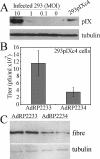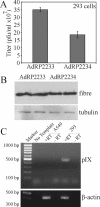Activation of adenoviral gene expression by protein IX is not required for efficient virus replication
- PMID: 15113884
- PMCID: PMC400331
- DOI: 10.1128/jvi.78.10.5032-5037.2004
Activation of adenoviral gene expression by protein IX is not required for efficient virus replication
Abstract
The adenovirus (Ad) protein IX (pIX) is a minor component of the Ad capsid and is in part responsible for virion stability; virions lacking pIX are heat labile and lose their infectivity if the DNA content is greater than approximately 35 kb. More recently, pIX has been identified as a transcriptional activator and, in transient-transfection assays, was shown to enhance expression from the E1A, E4, and major late Ad promoters by as much as 70-fold. In this study, we examined the role of pIX's ability to activate transcription during Ad replication. In transient-transfection assays, pIX had a minimal effect on expression from the E1A promoter, increasing expression by only 1.4-fold. We used helper-dependent Ad vectors, which had all Ad protein coding sequences deleted with the exception of E1A and which had capsids that either contained or lacked pIX, to show that pIX derived from decapsidation of the infecting virion does not influence expression of E1A. Similarly, expression of pIX from the Ad genome did not alter the expression levels of E1A. Viruses that had pIX deleted showed a threefold reduction in virus yield and expression of late genes compared to those of a similar virus which encoded pIX. This phenotype could not be rescued by growing the virus in cells which constitutively express pIX. Our results indicate that, although pIX can affect transcription from a variety of viral promoters, it does not appear to play a significant role in activation of Ad promoters during normal Ad replication.
Figures







References
-
- Boulanger, P., P. Lemay, G. E. Blair, and W. C. Russell. 1979. Characterization of adenovirus protein IX. J. Gen. Virol. 44:783-800. - PubMed
-
- Chen, L., M. Anton, and F. L. Graham. 1996. Production and characterization of human 293 cell lines expressing the site-specific recombinase Cre. Somat. Cell Mol. Genet. 22:477-488. - PubMed
-
- Flint, J., and T. Shenk. 1997. Viral transactivating proteins. Annu. Rev. Genet. 31:177-212. - PubMed
Publication types
MeSH terms
Substances
LinkOut - more resources
Full Text Sources
Other Literature Sources

